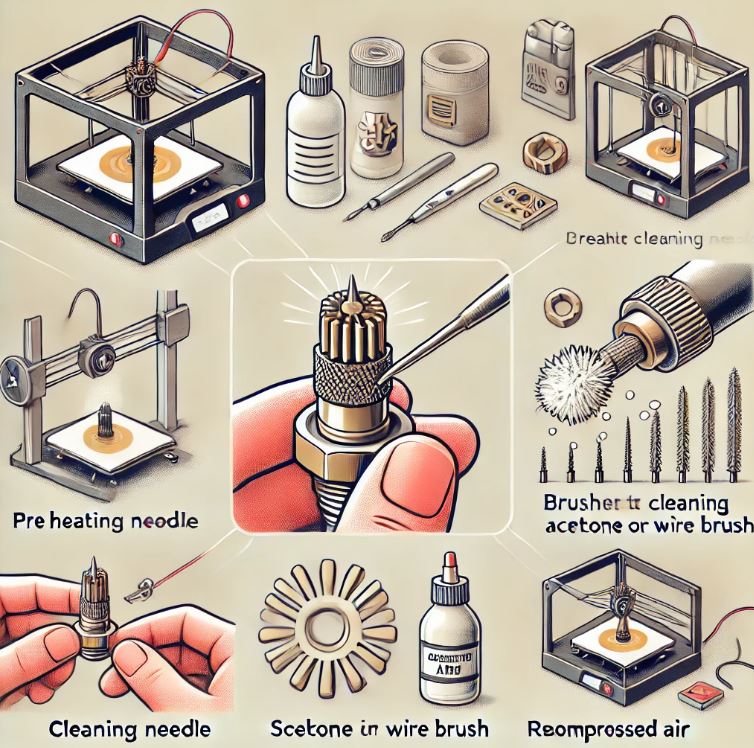I'm a participant in the Amazon Services LLC Associates Program, an affiliate advertising program designed to provide a means for me to earn fees by linking to Amazon.com and affiliated sites.
Keeping your 3D printer nozzle clean is crucial for maintaining optimal print quality and preventing clogs that can disrupt your projects. This guide will provide you with effective methods and tips on how to clean a 3D printer nozzle, ensuring your printer performs at its best.
Looking for a 3D printer that’s simple to use? Our guide on the best starter 3D printers shows you which ones are the easiest for newcomers to start using.
Key Takeaways
- Regular Maintenance: Regular cleaning of your 3D printer nozzle prevents clogs and ensures consistent print quality.
- Tools and Techniques: Use the right tools and techniques for effective cleaning.
- Expert Tips: Learn from top experts in the field to maintain your printer.
Why Cleaning Your 3D Printer Nozzle is Important
A clean nozzle is essential for producing high-quality 3D prints. Over time, filament residue and debris can build up inside the nozzle, leading to clogs and inconsistent extrusion. Regular maintenance helps prevent these issues and extends the life of your printer.
Tools You Need for Cleaning
To effectively clean your 3D printer nozzle, you’ll need the following tools:
- Needle or nozzle cleaning kit
- Brass wire brush
- Acetone or isopropyl alcohol
- Compressed air
- Pliers
- Nozzle removal tool
Step-by-Step Guide to Cleaning Your 3D Printer Nozzle
1. Preheat the Nozzle
Before you start cleaning, preheat the nozzle to the temperature recommended for the filament you last used. This softens any filament residue, making it easier to remove.
2. Use a Needle or Cleaning Kit
Carefully insert a cleaning needle or use a nozzle cleaning kit to dislodge any blockages. Gently move the needle up and down to clear the nozzle.
3. Brush the Nozzle
Once the nozzle is preheated and cleaned internally, use a brass wire brush to remove any external debris. This helps to clean off any filament residue on the outside of the nozzle.
4. Soak in Acetone or Alcohol
For thorough cleaning, you can soak the nozzle in acetone or isopropyl alcohol. This helps dissolve any remaining filament and debris. Make sure the nozzle is completely cool before soaking it.
5. Use Compressed Air
After soaking, use compressed air to blow out any remaining particles from the nozzle. This ensures that the nozzle is completely clear and ready for use.
6. Reinstall the Nozzle
Carefully reinstall the nozzle using a nozzle removal tool or pliers. Ensure it is securely fastened but do not overtighten it, as this can damage the threads.
Recent Developments in the Field
As of July 8, 2024, there have been several advancements in 3D printer maintenance tools. Newer cleaning kits with advanced nozzles and automated cleaning systems are becoming popular. These innovations help users maintain their printers more efficiently and reduce downtime caused by clogged nozzles.
Top Experts and Entities in the Field
Thomas Sanladerer
Thomas Sanladerer is a respected figure in the 3D printing community, known for his educational videos and in-depth reviews. His tutorials on printer maintenance are highly regarded. Check out his YouTube channel for expert advice.
MatterHackers
MatterHackers is a leading retailer of 3D printing materials and tools. They offer a wide range of maintenance products and resources to help users keep their printers in top condition. Visit MatterHackers for more information.
E3D Online
E3D Online specializes in high-performance 3D printer components, including nozzles and hotends. Their products are designed for durability and ease of maintenance. Learn more at E3D Online.
Internal Links – How to Clean a 3D Printer Nozzle
For further reading on related topics, check out these articles:
- Best 3D Printer for Beginners
- HP Smart Tank 5101 vs 5000
- Cool Things to 3D Print
- How to 3D Print a Dragon
Author: Regal Printer
Regal Printer is an expert in the 3D printing field with many years of experience. For more information and insights, visit their website.
